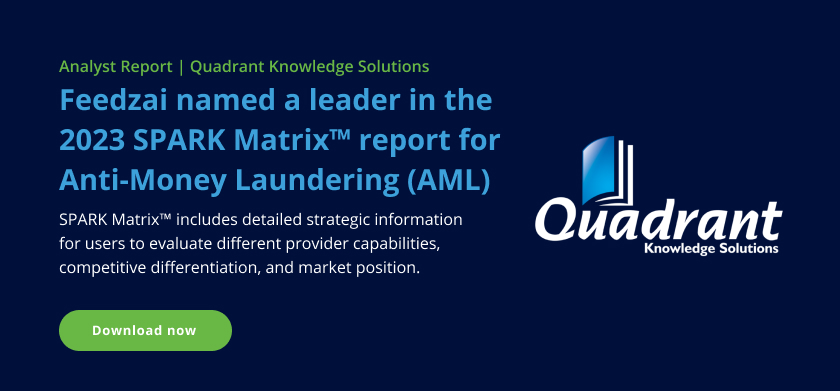A speaker at a financial crime conference I recently attended summed up the problem with legacy anti-money laundering (AML) systems quite eloquently. Too often, we’re simply putting digital lipstick on an analog pig. In other words, too many banks underestimate the complexity of their anti-money laundering systems architecture as they seek to deliver real-time AML decisions.
This complicated anti-money laundering systems architecture results in a higher cost of ownership for banks and financial institutions. Simply keeping legacy AML systems in place to appease the status quo won’t cut it, especially as the banking industry faces pressure to embrace real-time transaction monitoring in AML.
Banks are in an AML Innovation Arms Race — Whether They Realize It or Not
This year, we saw the tech giant Google partner with HSBC, an influential global bank, to launch an AI-powered solution for anti-money laundering. The solution, known as “Anti-Money Laundering AI” or “AMLAI,” is a cloud-based solution that uses artificial intelligence and machine learning technology to uncover suspicious transactions.
The partnership between a top tech player and a global financial institution effectively kicked off an arms race in the banking sector. Banks must innovate their AML programs, notably in transaction monitoring, to keep pace with the latest technological innovations. As banks look to implement real-time AML decisioning, they will need to prove the data they have provided is accurate, complete, and readily available.
4 Anti-Money Laundering Systems Architecture Challenges
Before financial institutions (FIs) can rush to innovate, they must first accept the shortcomings of existing AML legacy systems.
Legacy AML solutions are disparate
Too many AML systems are composed of multiple technologies at different maturity levels. The fact is they are disparate solutions of different technologies, vendors, and maturity, some in implementation, some much older, with a lot of IP and complexity written into them.
This arrangement means data can reside in multiple systems and is very difficult to support from the perspective of data analytics, data modeling, data availability, and data quality. Using multiple technologies also creates a complicated customer experience. End-users must log into several systems to obtain data. Since these systems don’t communicate clearly with each other, end-users could wind up with conflicting information, producing many false positive alerts. If the most recent and relevant data is unavailable, the lag time can affect customer screening, customer KYC processes, and transaction monitoring, making suspicious activity reporting difficult. This is further compounded when data is needed for AI and machine learning processing.
Moreover, governance of different systems can stretch operating systems and drive up the bank’s ownership cost. Overseeing and maintaining multiple systems requires bank staff to connect insights across various tools. Juggling several governance requirements results in operational and financial inefficiencies.
The end result is added strain on investigative staff. These professionals are expensive and passionate about AML. However, they can’t focus on where existing or new risk typologies reside or evolve because of existing governance. This isn’t good for the institution either because it increases the total cost of compliance.
Changing systems is an expensive undertaking
Banks invest a lot of effort and time into building the rules, scenarios, testing, and governance behind their anti-money laundering systems architecture. As a result, the cost and risk of change are incredibly high.
For example, if a bigger bank has invested $20 million in an AML system, the cost to change a solution may seem low. However, the cost to replicate the intellectual property and processes behind the system, and the update for approval and governance, can be greater than the original solution’s cost, license price, or implementation. In other words, banks have already invested large sums in their existing infrastructure and are reluctant to spend more to change it.
Changing the status quo is challenging
Finding a suitable replacement is not just challenging because of the technological requirements. There is also a tangible risk in replacing a legacy system that can affect multiple stakeholders.
A head of compliance like a Bank Secrecy Act (BSA) officer or a money laundering reporting officer won’t be easily swayed by a vendor claiming they can reduce operational costs by 20% by implementing a new solution. Instead, these professionals want proof that the new solution won’t miss any risk coverage like potential money laundering transactions. If the new solution fails to do its job, these team members could cause a non-compliance problem or land in legal trouble.
Updating or even adjusting an AML system can be costly. But winning the hearts and minds of different organizational stakeholders can be even more challenging – and expensive.
Too much vendor noise
Even if stakeholders agree that their AML legacy system requires an update, the question remains: which vendor to choose?
If you’re like me, your inbox is probably overflowing with vendor outreach messages promising to fix some of your most pressing issues. Bringing new technologies into a bank’s infrastructure involves a rigorous procurement process. Even after completion, a bank’s IT or engineering team may return to the vendor for specific questions.
In the worst-case scenario, imagine the vendor shutters or goes out of business. The bank will have invested in a costly solution and cannot connect with anyone who understands how the solution works.
How Banks Can Improve AML System Architecture
As banks seek to implement real-time transaction monitoring, they must address some of the maintenance challenges of their existing anti-money laundering systems architecture. Here’s how banks can embrace solutions that enable smarter AML maintenance.
Pick scalable solutions
Any AML solutions a bank implements should not be static. Instead, it should be flexible enough to evolve with changing needs and circumstances. On-prem solutions are ill-suited for this reality. It’s smarter to rely on cloud-based solutions to connect to your bank’s network to install patches and run updates. This arrangement also offsets the need to procure new physical servers and hardware.
Focus on cost reduction
Scalability should be sufficiently elastic, so you’re operating at peak capacity. If you have a lot of headroom you’re not using, there’s a cost associated with that. A cloud-based infrastructure can scale up and down and cost exact demand at a precise time rather than carrying an overhead of capacity. The elasticity of demand requirements of the capacity provision. Look for solutions that enable banks to pay for capacity as needed, resulting in smarter AML infrastructure spending. They should also allow greater flexibility for testing new highly data-intensive typologies with large historical data sets.
Focus on compliance-oriented requirements
Data moves quickly in the digital age. Any solution a bank implements should be managed as if in your own environment. Banks relying on a 3rd party vendor to handle data must ensure the vendor complies with the jurisdictions where the bank operates.
Whether they like it or not, the banking industry is essentially in an arms race regarding innovation. New innovations are being released on a regular basis. Banks that fail to adapt quickly or that adapt to today’s groundbreaking innovation in five years will likely be 10 years behind their competitors.
Legacy anti-money laundering systems architecture has numerous maintenance challenges and a high bank ownership cost. While many stakeholders are likely reluctant to embrace updates and changes to their AML systems architecture, waiting to innovate is not an option. Recent high-profile partnerships between banking and technology organizations demonstrate that real-time AML transaction monitoring is on the horizon.
To prepare for this new reality, banks must enhance their anti-money laundering systems architecture with the latest solutions. Otherwise, both customers and regulators alike will be able to detect the pig beneath the lipstick.
Share this article:
Related Posts
0 Comments5 Minutes
Spotlight on Denmark: Fraud and Financial Crime Insights from ‘Den sorte svane’
The recent documentary mini-series "Den sorte svane" has sent shockwaves through Danish…
0 Comments9 Minutes
Enhancing AML Transparency with Smarter Data
Doesn’t it seem like new financial threats crop up in the blink of an eye? That’s why…
0 Comments8 Minutes
Avoid AML False Positives in 3 Easy Steps
High false positive rates are considered the norm for many financial institutions. But…


